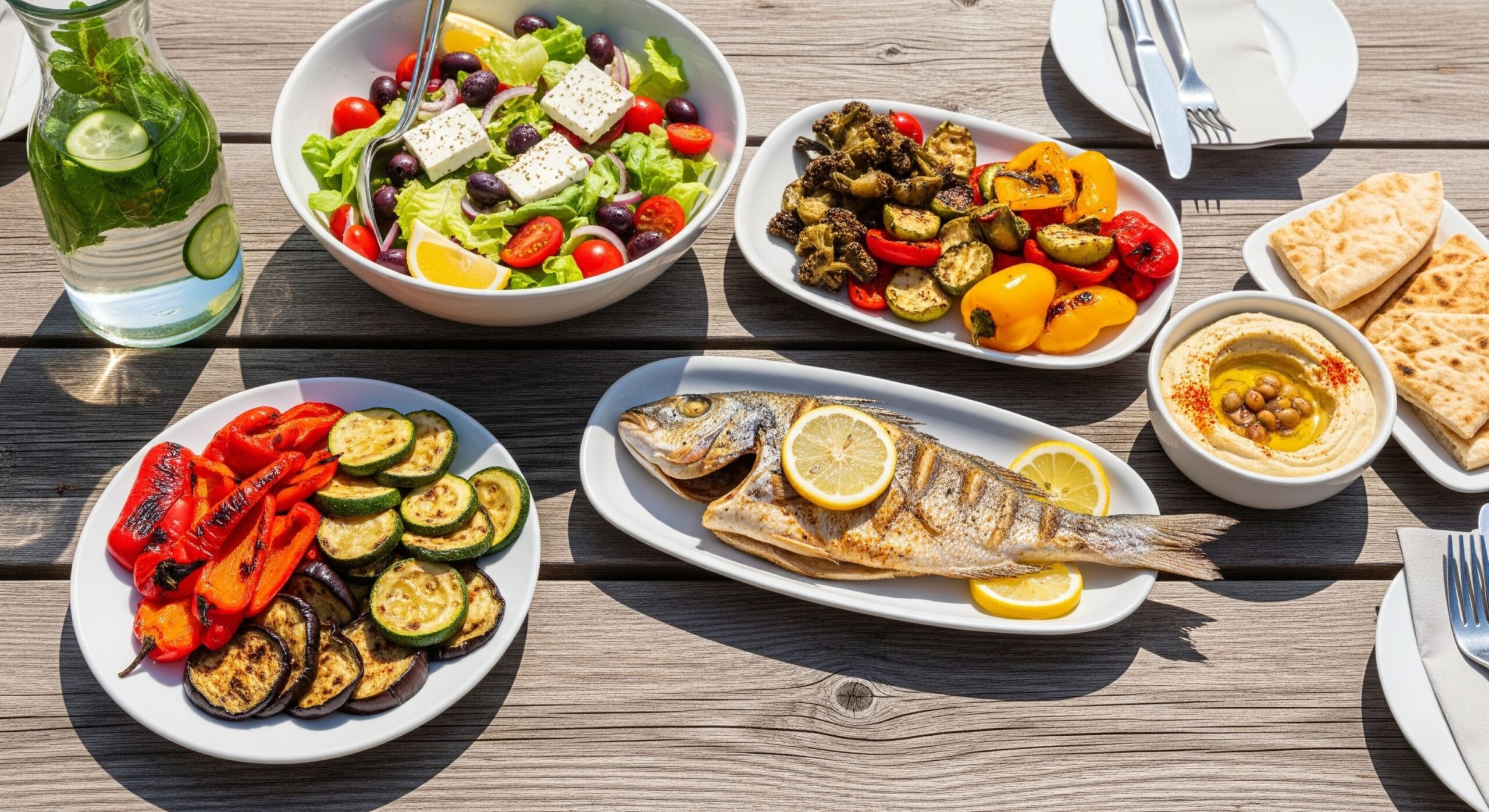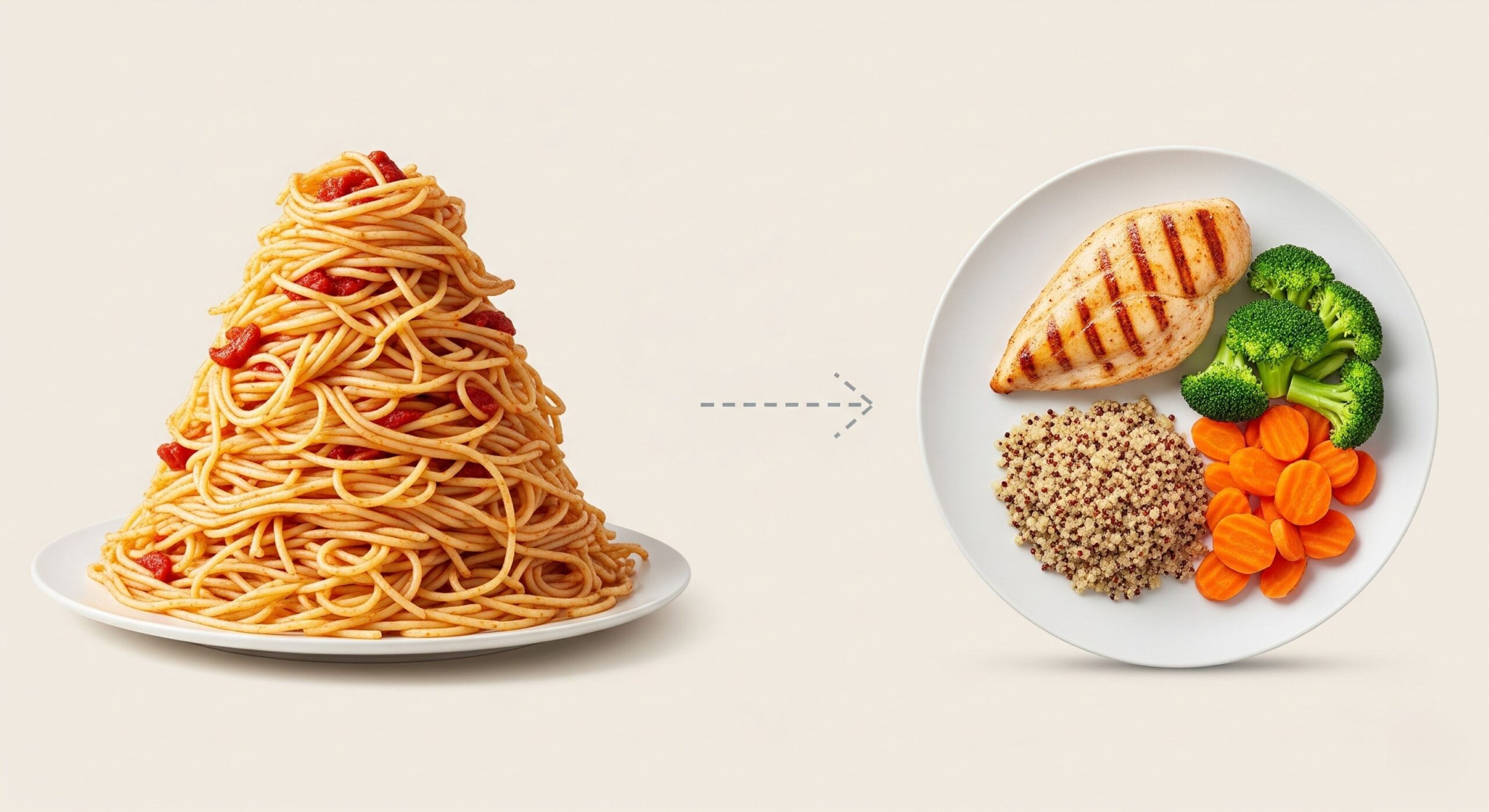Let’s be honest: when it comes to weight loss, the idea of starting another miserable diet is exhausting. But what if the secret to lasting results isn’t a diet at all? In reality, the real key is building a sustainable lifestyle with healthy diet plans you can actually enjoy. This guide, therefore, dives into powerful, no-nonsense strategies for successful, long-term weight management. We’re cutting through the noise of fad diets to help you build habits that stick and, most importantly, create a positive relationship with food for good.

The Mediterranean Diet: A Top Choice for Healthy Diet Plans
First up, let’s talk about a rockstar in the health world: the Mediterranean diet. Doctors and researchers constantly praise it, and for good reason. But here’s the best part: it’s less of a strict diet and more of a vibrant, delicious way of life. Inspired by the eating habits in places like Greece and Italy, this approach lets you ditch the calorie counting and focus on whole, nutrient-packed foods. For instance, imagine plates loaded with fresh fruits and veggies, whole grains, beans, nuts, and healthy fats like olive oil. Fish and chicken make regular appearances, while red meat becomes more of a special occasion treat. Consequently, this lifestyle is one of the most effective healthy diet plans because it’s about enjoying meals with others and staying active.
“The Mediterranean diet… is a powerful tool to reduce cardiovascular risk… it is not only a diet but a lifestyle.”
— Journal of the American College of Cardiology Source
Moreover, the benefits go way beyond weight loss. Study after study links the Mediterranean diet to better heart health by slashing the risk of heart disease and stroke. It’s also great for keeping blood sugar in check and may even help protect your brain as you age. When it comes to losing weight, it works because the food is naturally filling. The high fiber and healthy fats keep hunger away, so you’re much less likely to overeat or grab junk food. In short, it’s a commonsense approach that makes it one of the best healthy diet plans out there.
Low-Carb vs. Balanced: Finding Your Healthy Diet Plan
Now for the age-old debate: should you ditch carbs or find a balance? Let’s break down the low-carb and balanced diets. Low-carb plans like keto, for example, have you drastically cut carbs and increase your fat intake, which forces your body to burn fat for fuel. Sure, this can kickstart rapid weight loss, which feels fantastic at first. For many people, however, the strict rules can feel isolating and become incredibly tough to maintain long-term. Plus, if you’re not careful, you could miss out on key nutrients.
On the other hand, a balanced approach is all about smart moderation. It includes healthy portions of all three macronutrients: carbs, proteins, and fats. Instead of banning carbs, you learn to choose the right ones—like quinoa, sweet potatoes, and whole-grain bread—that give you lasting energy. This is a world away from the refined carbs in sugary snacks that lead to an energy crash. For most people, a balanced plan is simply more realistic and sustainable. It’s flexible and teaches you how to eat well for life, not just for a few weeks, making it the core of any healthy diet plan that you can actually stick with.

Portion Control: The Simple Art of Eating Enough
Let’s bust a myth right now: portion control does not mean starving yourself. In fact, it’s not about deprivation at all—it’s about getting smart with your servings and learning to listen to your body. Think of it as a skill, and it’s one you can definitely master.
Case Study: Jane’s Plate
Jane, a 45-year-old marketing manager from Chicago, was frustrated. She was eating healthy foods but still couldn’t lose weight. The culprit? Portion distortion. She would free-pour her morning cereal and pile pasta high on a dinner plate. The fix wasn’t cutting out her favorite meals, but simply being mindful of how much she was eating. As a result, Jane started using a measuring cup for her cereal and switched to a smaller dinner plate. This simple visual trick helped her feel satisfied with less food. Within weeks, she started seeing results—all without giving up the foods she loved.
You can use these hacks too. For starters, smaller plates and bowls can be your best friends. When you eat out, where portions are often huge, ask for a to-go box right when you order and pack up half your meal immediately. Out of sight, out of mind. Ultimately, the biggest game-changer is tuning into your body’s hunger cues. Eat when you’re hungry, and stop when you’re satisfied, not stuffed. As the CDC wisely puts it, “Losing weight is not about making radical changes… but about making small, sustainable changes.” That’s what a smart healthy diet plan is all about.
Meal Timing: More Than Just What You Eat
You already know that what you eat matters, but it turns out that when you eat can be a game-changer, too. The old advice to never skip breakfast really holds up. When you start your day with a protein-packed meal, you stabilize your blood sugar and are better able to dodge those 10 AM cravings for donuts in the breakroom. In short, it sets the tone for a day of smart choices.
Furthermore, consider front-loading your calories. Your body is better at burning fuel earlier in the day when you’re most active. A bigger lunch and a lighter dinner can help prevent weight gain and even lead to better sleep. Then there’s intermittent fasting, where you cycle between eating and fasting periods—for example, eating only within an 8-hour window each day. While it can be an effective tool for some, it’s not a magic bullet for all healthy diet plans. At the end of the day, the best eating schedule is the one that fits your life and makes you feel your best.
The Social Plate: How Your Environment Shapes Your Eating
It’s easy to think of eating as a purely personal choice, but in reality, our environment plays a huge role. Think about it: family gatherings centered around heavy dishes, office parties loaded with treats, or even just the layout of your local grocery store. Navigating these situations is a key, but often overlooked, part of a healthy lifestyle.
Instead of avoiding social events, for instance, try bringing a healthy dish to share. This puts you in control and ensures there’s at least one option you feel great about. At parties, position yourself away from the snack table to avoid mindless munching. Similarly, try to survey all the options at a buffet before putting anything on your plate; this helps you make more conscious choices. Most importantly, focus on the conversation and the company. Shifting your focus from the food to the people can make a world of difference. These small strategies allow you to enjoy your social life without derailing your goals. It’s about adapting, not isolating.
Embracing Food Freedom: A Psychological Approach
Okay, this might be the most important takeaway of the entire guide. Let’s talk about your relationship with food. For too long, diets have trapped us in a negative cycle of strict rules, guilt, and failure. “Food freedom” is the way out. It’s about ditching the diet mentality and learning to trust your body again. It means you honor your hunger, enjoy your food without guilt, and see eating as a way to nourish yourself, not punish yourself. It’s no wonder the American Psychological Association warns that traditional dieting often backfires, leading to a yo-yo effect of weight loss and gain.
Anecdote: Mark’s Pizza Night
Take Mark, a 32-year-old graphic designer. He was stuck in a “clean eating” trap, where one ‘bad’ food choice would make him feel like a failure, often leading to a weekend binge. His turning point wasn’t a new diet, but a simple mindset shift. He started viewing food as fuel and joy, not as a moral test. As a result, he planned for a slice of his favorite pizza on Friday nights, savoring it without guilt. Paradoxically, by allowing himself this freedom, his desire to binge disappeared, and he found a sustainable balance he’d been missing for years.
“Intuitive Eating… focuses on trusting your own body and its inner signals, rather than relying on external diet rules.”
Once you stop labeling foods as “good” or “bad,” they lose their power over you. Consequently, you build a healthier mindset where you can enjoy a brownie without feeling like you’ve completely failed. This mental shift from restriction to respect is often the final piece of the puzzle for achieving weight loss that truly lasts.
Your Food Guide for Healthy Diet Plans
Feeling lost in the grocery store? Don’t be. Here’s a simple cheat sheet for your healthy diet plan, breaking down what to pile in your cart and what to leave on the shelf.
Foods to Include and Embrace:
- Lean Proteins: These are the building blocks of a healthy body. They keep you full and help build muscle. Go for chicken, fish, eggs, and plant-based powerhouses like beans and lentils.
- Whole Grains: These are carbs that work for you, packed with fiber and nutrients. Think quinoa, oats, brown rice, and whole-wheat bread.
- Fruits and Vegetables: Eat the rainbow. These are low-calorie, high-fiber superstars. Aim to fill half your plate with them at every meal.
- Healthy Fats: Yes, you need fat! The good kind from avocados, nuts, seeds, and olive oil keeps you full and supports brain health.
- Hydration: Water is your secret weapon. Staying hydrated boosts your metabolism and helps control hunger. But you’re not limited to plain water! Unsweetened herbal teas, sparkling water with a squeeze of citrus, and even the water from fruits and vegetables contribute to your daily intake.
Foods to Limit or Avoid:
- Processed and Packaged Foods: If it comes in a crinkly bag or a box with a long ingredient list, be wary. These are often loaded with sugar, unhealthy fats, and sodium.
- Sugary Drinks: Soda, sweet teas, and many juices are calorie bombs that offer almost zero nutritional value. Stick to water.
- Excessive Saturated and Trans Fats: Found in fried foods and many packaged snacks, these are bad news for your heart.
- Hidden Sugars and Fats: Be a detective with your food labels. Salad dressings, ketchup, pasta sauces, and marinades can be packed with surprising amounts of sugar and unhealthy fats, turning an otherwise healthy meal into a less-than-ideal choice.
Simple Exercise Routines You Can Do at Home
While diet is crucial, exercise is the perfect partner for any effective healthy diet plan. It torches calories, builds metabolism-boosting muscle, and also makes you feel amazing. The best part? You don’t need a pricey gym membership. Here are five killer moves you can do right in your living room.

Key Exercises to Get Started
Here are a few simple exercises to get you started:
- Bodyweight Squats: The ultimate lower-body move. Stand with feet shoulder-width apart and sit back like you’re aiming for a chair. Remember to keep your chest up!
- Push-ups (on your knees or toes): A classic for a reason. They build upper body and core strength. Start from your knees if you’re just beginning.
- Planks: This move looks simple, but it’s a total-body challenge. Hold a push-up position (on your hands or forearms) and keep your body in a dead-straight line.
- Jumping Jacks: An old-school cardio blast that gets your heart pumping in seconds.
- Lunges: Perfect for toning your legs and glutes. Step forward, lower your hips until both knees are at a 9-degree angle, then push back to the start.
Aim for 3 sets of 10-15 reps for each move, or just do as many as you can in 30-60 seconds. Then, string them together for a quick circuit workout 3-4 times a week. Above all, more important than intensity is consistency. A 15-minute workout done four times a week is far more effective than a grueling hour-long session done once a month. The American College of Sports Medicine confirms that “regular physical activity is an integral part of a healthy lifestyle.”
Beyond the Workout: The Power of NEAT
Don’t forget the power of NEAT (Non-Exercise Activity Thermogenesis). This is the energy you burn from everyday movements. In other words, look for small opportunities to move more: take the stairs instead of the elevator, park further from the store entrance, pace while you’re on the phone, or do a few stretches during TV commercials. These small bits of activity add up significantly over time and are an easy way to boost your overall calorie burn without hitting the gym.
Putting It All Together: Building Your Personal Healthy Diet Plan
So, what does the perfect “healthy diet plan” actually look like? In truth, it’s not a pre-written script—it’s one you create yourself. A truly sustainable plan is less of a ‘plan’ and more of a personal food philosophy built on the principles we’ve discussed. Specifically, it’s about filling your plate with whole foods (think Mediterranean style), understanding portion sizes without obsessing, and listening to your body’s natural hunger cues. The best healthy diet plans are flexible enough to handle a dinner out with friends and forgiving enough that one dessert doesn’t ruin your week. Start by making one or two small changes, like adding a vegetable to every meal or swapping soda for water. Then, build from there, and create a way of eating that serves your body and your life.
Bonus Tip: The Overlooked Secret to Weight Loss
Want to know a secret weapon in your weight loss journey that doesn’t involve food or exercise? It’s sleep! Seriously, not getting enough quality sleep can completely sabotage your best efforts. When you’re sleep-deprived, for instance, your body produces more ghrelin, the hormone that tells you you’re hungry, and less leptin, the hormone that signals you’re full. This hormonal imbalance can lead to intense cravings for sugary and fatty foods. Therefore, aiming for 7-9 hours of quality sleep per night can help regulate your appetite, boost your metabolism, and give you the energy you need to stay active. Think of it as hitting the reset button for your body every single night.
Frequently Asked Questions (FAQ)
What is the healthiest diet plan for beginners?
For beginners, the best approach is to focus on balanced, whole foods rather than extreme restrictions. The Mediterranean diet is an excellent starting point because it’s flexible and emphasizes nutrient-rich foods like fruits, vegetables, whole grains, and lean proteins. Ultimately, the key is to choose a plan that feels sustainable and enjoyable for you.
How long does it take to see results with a healthy diet plan?
While some benefits like increased energy and better mood can be felt within a few days, noticeable weight loss typically occurs within the first few weeks of consistent effort. However, remember, sustainable weight loss is a gradual process. Focus on building long-term habits rather than seeking quick fixes.
Can I still eat my favorite foods on a healthy diet plan?
Absolutely! A successful healthy diet plan is about moderation and balance, not total deprivation. In fact, there is always room for your favorite treats. The goal is to build a healthy lifestyle where you can enjoy these foods mindfully without feeling guilty, making them part of a balanced diet rather than “forbidden” items.
What should I do if my weight loss stalls?
Weight loss plateaus are completely normal. When they happen, consider a few things. For example, are your portion sizes creeping up? Could you increase the intensity or duration of your workouts? Sometimes, your body just needs time to adjust. Stay consistent with your habits, ensure you’re getting enough sleep, and be patient. In time, the progress will likely resume.
Sources and References
- World Health Organization. “Healthy diet.” Accessed September 1, 2025.
- Journal of the American College of Cardiology. “The Mediterranean Diet: A Timeless Blueprint for Health.”
- NHS UK. “12 tips to lose weight.” Accessed September 1, 2025.
- Centers for Disease Control and Prevention. “Healthy Eating for a Healthy Weight.”
- American Psychological Association. “The diet-industry is a sham and science shows it is not a sustainable way to lose weight.”
- The American Journal of Clinical Nutrition. “The Role of Intuitive Eating in Health and Weight Management.”
- American College of Sports Medicine. “ACSM’s New Recommended Quantity and Quality of Exercise for Developing and Maintaining Cardiorespiratory, Musculoskeletal, and Neuromotor Fitness in Apparently Healthy Adults: Guidance for Prescribing Exercise.” Accessed September 1, 2025.
Your Interactive Guide to a Healthier You
The Mediterranean Way
- Whole Foods: Fruits, Veggies, Grains
- Healthy Fats: Olive Oil, Nuts
- Lean Protein: Fish, Poultry
- A lifestyle, not a strict diet
Mindful Portions
- Use Smaller Plates
- Listen to Your Body’s Cues
- Manage Portions Dining Out
- Awareness, Not Deprivation
A Healthy Mindset
- No ‘Good’ or ‘Bad’ Foods
- Eat Mindfully & Without Guilt
- Trust Your Body’s Signals
- Focus on Balance
Simple Home Workouts
- Bodyweight Exercises are Effective
- Try: Squats, Push-ups, Planks
- Add Cardio: Jumping Jacks
- Consistency Over Intensity

